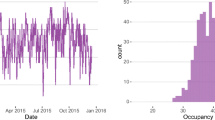Abstract
This paper presents a new approximation approach, called tagged user approach (TUA), for the queueing analysis of slotted CSMA/CD systems with a finite user population having either finite or infinite user buffer capacity. By assuming a symmetric channel, the performance analysis of the overall system is determined by the performance of an arbitrarily selected user, called the tagged user. With the further assumption that each user always operates with its equilibrium probability, the packet service time distribution can be obtained using a state flow graph by studying the channel contention scheme. The obtained packet service time distribution is then applied to the queueing analysis of the tagged user using the standard queueing theory. That is, the analysis of the channel contention scheme and the analysis of the user queueing behavior are decoupled in this paper. Hence, TUA can be applied to complicated systems such as those where each user buffer may have bulk packet arrivals and random service discipline as long as the corresponding queueing theory is available. Since a state transition probability matrix is not required in TUA, the required amount of computation is quite small. Simulation results verify the high accuracy of the analysis.
Similar content being viewed by others
References
Man-Keung Lo and Tak-Shing P. Yum, “The Tone Sense Multiaccess Protocol with Partial Collision Detection (TSMA/PCD) for Packet Satellite Communications”, IEEE Trans. Comm., Vol. 41, pp. 820–824, 1993.
CDPD Forum Inc., Cellular Digital Packet Data System Specification: Release 1.1, 19 January 1995.
F.A. Tobagi and V.B. Hunt, “Performance Analysis of Carrier Sense Multiple Access with Collision Detection”, Computer Networks, Vol. 4, pp. 245–259, 1980.
E.D. Sykas, D.E. Karvelas and E.N. Protonotarios, “Queueing Analysis of Some Buffered Random Multiple Access Schemes”, IEEE Trans. on Comm., Vol. COM-34, No. 8, pp. 790–798, 1986.
A.O. Fapojuwo, W.C. Chan and D. Irvine-Halliday, “An Iterative Approximation for Modelling Buffered CSMA-CD LAN's, Journal of Electrical and Electronics Engineering, Vol. 8, No. 2, pp. 102–111, 1988.
S. Tasaka, Performance Analysis of Multiple Access Protocols, The MIT Press, 1986.
S. Tasaka, “Dynamic Behavior of a CSMA-CD System with a Finite Population of Buffered Users”, IEEE Trans. on Comm., Vol. COM-34, No. 6, pp. 576–586, 1986.
T.K. Apostolopoulos and E.N. Protonotarios, “Queueing Analysis of Buffered CSMA/CD Protocols”, IEEE Trans. on Comm., Vol. COM-34, pp. 898–905, 1986.
A. Ganz and I. Chlamtac, “A Linear Solution to Queueing Analysis of Synchronous Finite Buffer Networks”, IEEE Trans. on Comm., Vol. 38, pp. 440–447, 1990.
A. Ganz and I. Chlamtac, “An Efficient Solution to Finite Buffer Non-Persistent Carrier Sense Multiple Access Protocol”, Computer Networks and ISDN Systems, Vol. 18, pp. 263–274, 1989/90.
J. Silvester and I. Lee, “Performance Modeling of Buffered CSMA–an Iterative Approach”, Globecom '82, pp. 1195–1199, 1982.
T.K. Apostolopoulos and E.N. Protonotarios, “Queueing Analysis of Buffered Slotted Multiple Access Protocols”, Comput. Commun., Vol. 8, pp. 9–21, 1985.
H. Takagi, Queueing Analysis–A Foundation of Performance Evaluation, Vol. 3: Discrete-Time Systems, North-Holland Publishing Company, 1993.
H.H. Tan and K. Tsai, “Packet Output Processes of CSMA and CSMA/CD Protocols”, IEEE Trans. on Comm., Vol. 44, pp. 464–474, 1996.
Y. Matsumoto, Y. Takahashi and T. Hasegawa, “The Effects of Packet Size Distributions on Output and Delay Processes of CSMA/CD”, IEEE Trans. on Comm., Vol. 38, pp. 199–214, 1990.
S.L. Beuerman and E.J. Coyle, “The Delay Characteristics of CSMA/CD Networks”, IEEE Trans. on Comm., Vol. 36, pp. 553–563, 1988.
T. Takine, Y. Takahashi and T. Hasegawa, “An Approximate Analysis of a Buffered CSMA/CD”, IEEE Trans. on Comm., Vol. 36, pp. 932–941, 1988.
Y. Matsumoto, Y. Takahashi and T. Hasegawa, “Probability Distributions of Interdeparture Time and Response Time in Multipacket CSMA/CD Systems”, IEEE Trans. on Commun., Vol. 38, pp. 54–66, 1990.
R.A. Howard, Dynamic Probabilistic Systems, Volume II: Semi-Markov and Decision Processes, John Wiley & Sons, 1971.
W.A. Wolovich, Automatic Control Systems: Basic Analysis and Design, Saunders College Publishing, 1994.
Author information
Authors and Affiliations
Rights and permissions
About this article
Cite this article
Wan, T., Sheikh, A.U. Performance Analysis of Buffered CSMA/CD Systems. Wireless Personal Communications 18, 45–65 (2001). https://doi.org/10.1023/A:1011247909837
Issue Date:
DOI: https://doi.org/10.1023/A:1011247909837




